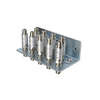If, in the UK, you are in a fairly built-up area, then, IMHO, it's likely that there will be steel-framed highrise buildings (office blocks, blocks of flats, industrial buildings, etc.) that would "attract" the relatively few lightning strikes that we normally get.
That said, I grounded all the dishes 20m down the garden to the 2x scaffolding poles that support the ground-mounted Gibby and the TD110, and, hopefully, that would divert any "high-current" pulses directly to "ground" before they actually get to the house - but the EMP from them would probably still "take out" any electronic kit within hundreds of metres,
regardless of whether you have fitted GDT's or similar devices,
or not 
.
Thus, you "pays your money and takes your choice"

.
PS: to anyone who doesn't know the acronym "EMP", it stands for "ElectroMagnetic Pulse" - the VERY high radiated wideband Radio Interference pulse from lightning strikes (and nuclear explosions!) that has been shown to "fry" electronic circuits in all sorts of kit (bring back basic diesel engines with absolutely NO electrical circuits, 'cause that's probably the only form of motor that would continue to work after an EMP)


 .
.